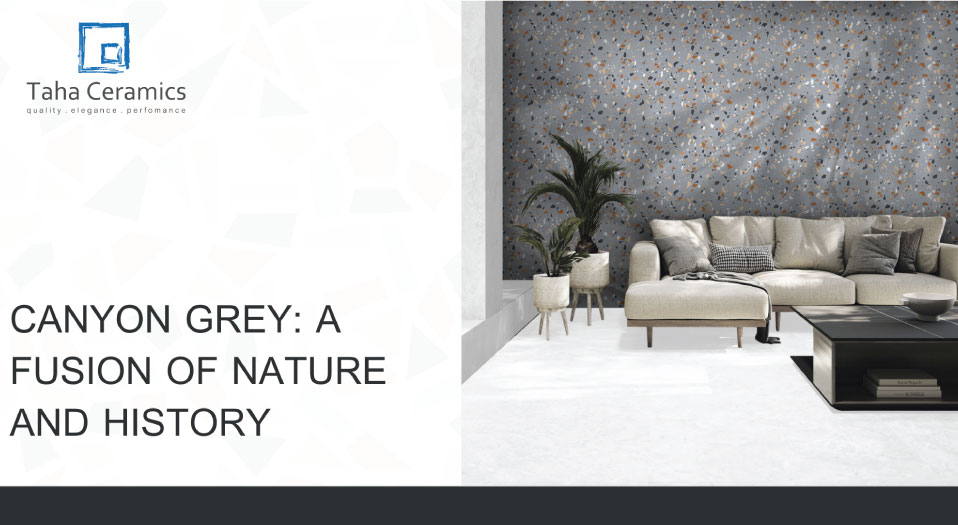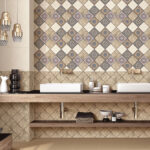Canyon Grey is a terrazzo tile that brings together the rugged beauty of the Serengeti and the historical grandeur of Zanzibar’s Stone Town. Named to evoke the deep, enduring landscapes of East Africa, this tile transcends mere aesthetics, offering a connection to the land, culture, and heritage of two iconic locations. By combining the earthy tones of the Serengeti with the weathered textures of Zanzibar’s architecture, Canyon Grey tells a story that spans both time and place, transforming a simple design into a tribute to nature and history.
l. The Serengeti: Nature’s Enduring Beauty
The Serengeti, one of the world’s most iconic landscapes, serves as a primary source of inspiration for the color palette and texture of Canyon Grey. The vast plains of the Serengeti are home to some of Africa’s most stunning and diverse ecosystems, where the colors of the earth vary from golden browns to deep greys, ochres, and blacks. These tones are mirrored in the terrazzo tile, which features a combination of muted greys and soft earth hues that evoke the wild, unspoiled beauty of the African savannah.
The Serengeti is shaped by natural forces, with rock formations, canyons, and rolling hills that have been carved over millions of years. Canyon Grey captures this timelessness through its textured surface and subtle veining. Just as canyons form through the slow, patient erosion of rock, the tile’s organic patterns reflect the enduring passage of time in the natural world. The terrazzo aggregates—small fragments of stone, quartz, and marble—represent the natural elements that shape the Serengeti’s landscape, from the windswept plains to the majestic rock formations that dot the region.
The deep, rich greys in the tile evoke the dramatic skies of the Serengeti at dusk, while the ochre tones recall the golden grasses that blanket the savannah, changing color with the seasons. The darker flecks of the terrazzo represent the shadowed ravines and hidden corners of the Serengeti, where wildlife thrives away from the open plains. By incorporating these natural hues and textures, Canyon Grey invites you to feel connected to the wild beauty of one of the world’s most remarkable ecosystems.
Zanzibar’s Stone Town: History Carved in Stone
In addition to the Serengeti’s wild landscapes, Canyon Grey is also inspired by Stone Town, the historical heart of Zanzibar. This UNESCO World Heritage site is known for its distinctive architecture, which blends African, Arab, Indian, and European influences into a harmonious whole. The buildings in Stone Town are primarily made from coral stone, a material that is unique to the region and that gives the town its characteristic greyish tones. The coral stone’s natural weathering over time produces a patina that is both beautiful and historic, a feature that is reflected in the color palette of Canyon Grey.
Stone Town’s architecture is a stunning testament to the cultural crossroads of Zanzibar, where Swahili, Arab, and European traders and settlers left their marks over centuries. The buildings, many of which are centuries old, are adorned with intricate stonework, arched doorways, and ornate wooden carvings. These details are echoed in the terrazzo tile’s design, which combines soft greys with small, embedded aggregates that resemble the texture of coral stone. The result is a tile that is not only visually striking but also rich with historical meaning.
The grey tones of Canyon Grey evoke the weathered coral stone walls of Stone Town’s buildings, which have stood the test of time, weathering the salty sea breeze and the harsh equatorial sun. Just as Zanzibar’s buildings have been shaped by centuries of history, Canyon Grey carries a sense of age and permanence, linking the past with the present. The texture of the tile, with its subtle variations and natural imperfections, reflects the passage of time in Stone Town, where every crack and carving tells a story of cultural exchange, trade, and resilience.
The Harmony of Serengeti and Stone Town: A Unified Design
What makes Canyon Grey so compelling is its ability to blend two seemingly distinct influences—the untamed nature of the Serengeti and the architectural richness of Zanzibar—into a single cohesive design. The tile’s color palette and texture combine to create a visual narrative that celebrates both natural beauty and cultural heritage.
The design of Canyon Grey reflects the harmony between these two worlds. The Serengeti’s wild beauty is captured through the earthy tones and subtle veining that suggest the movement of wildlife across vast plains and the slow, continuous shaping of the land by wind, water, and time. The weathered coral stone of Zanzibar’s Stone Town is reflected in the tile’s grey base, which speaks to the town’s rich history and the unique beauty of its stone buildings.
This fusion of natural and historical elements creates a tile that is not only visually captivating but also deeply meaningful. Canyon Grey becomes more than just a material—it serves as a bridge between the past and present, between the earth and the built environment. It embodies the resilience of nature and the enduring legacy of human culture, making it an ideal choice for spaces that seek to evoke both timelessness and contemporary elegance.
A Tile That Tells a Story
At its core, Canyon Grey is a story told through design. It’s a celebration of the Earth’s natural beauty, shaped over millennia, and the cultural significance of Zanzibar’s Stone Town, whose buildings and stones have withstood the test of time. Whether used in residential interiors, commercial spaces, or public buildings, Canyon Grey adds a sense of place and history to any environment. Its rich, earthy tones and textured surface evoke a connection to the landscapes and cultures of East Africa, offering a unique way to incorporate the beauty of the Serengeti and the heritage of Zanzibar into modern design.
In this way, Canyon Grey is not just a tile, but a journey—one that connects the untamed beauty of nature with the cultivated richness of human history. It’s a design that resonates with those who seek to bring a deeper meaning into their spaces, creating environments that are as timeless and enduring as the places that inspired them.



